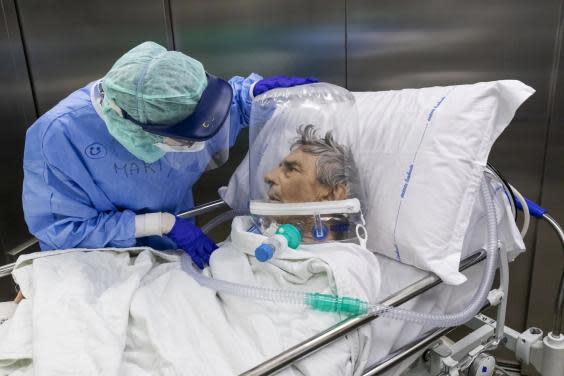‘We made it’: Medics recount emotional moment Bergamo hospital ICU declared coronavirus-free

The last Covid-19 patient in Bergamo’s main coronavirus hospital was a 51-year-old man. He had been infected with a very severe form of the virus, which caused his lungs to fail and involved other organs. But on 8 July, after more than two months, he was able to leave the intensive care unit.
Staff gathered in the hall and held a minute of silence to mourn all of Bergamo’s coronavirus deaths – then the silence gave way to a euphoric round of applause. It was over. After more than four months, the ICUs in Papa Giovanni XXIII hospital were declared coronavirus-free.
“We can say we made it,” Luca Lorini, 59, the head of the hospital’s resuscitation department, tells The Independent. “We don’t know if the coronavirus will attack us again, but we have won this battle.”
Signs of a newly found normality are everywhere in Bergamo, once the epicentre of Europe’s coronavirus crisis. Residents are again flocking to shopping malls and outdoor bars in parks, although wearing a mask is still compulsory. Patients have begun to book check-ups and elective treatment like colonoscopies and ultrasounds.
And the hospital staff are back at their original jobs, working through the backlog of surgeries that were left behind when doctors were transferred onto Covid-19 care and residents shunned the hospital for fear of being infected.
Bergamo, la Terapia intensiva libera dal Covid dopo 137 giorni https://t.co/TZOs5LJn94 pic.twitter.com/NiQVs4zz1j
— Corriere della Sera (@Corriere)
“It’s a feeling of liberation,” says Mario Mezzapesa, a resuscitator specialising in cardiovascular surgery. The ICU he worked on – like all the others – was transformed to deal exclusively with coronavirus patients in intensive care, but he has now gone back to working on heart transplants and heart surgery. Between 20 and 30 patients who had Covid-19 are still recovering in the hospital’s main wards, but he now visits patients with only a facemask and without all the other PPE.
“All this seemed unimaginable just a few weeks ago,” he says.
For several weeks in March and April, Bergamo was at the centre of the pandemic and the world’s worst-hit town – more than 3,000 people died and a further 15,000 were infected by the disease. It sits in the region of Lombardy in Italy’s north, which suffered 16,748 deaths – half of the country’s total.
“There were so many dead; I hope people won’t forget,” says Sara Cattaneo, a nurse who is back working in the hospital’s heart surgery ICU. “In almost all families and groups of friends, there was somebody who lost a person.”
The photos of obituaries filling up local newspapers, churches filled with coffins and army trucks taking those coffins to other cities to be cremated made headlines across the world.
The hospital came under immense pressure: staff treated more than 2,000 Covid-19 patients; 300 in ICUs. “To my knowledge, this was the biggest in-hospital ICU in the world after Wuhan,” Lorini says, with some 100 patients treated in ICUs at one time in the peak of the crisis in March.
Papa Giovanni XXIII hospital was carrying and supplying 100 times the amount of oxygen it did before the coronavirus. “Picture this,” he repeats. “Not double the amount: 100 times.”

The task piled pressure on health professionals, too. During a normal shift, Lorini says some staff reported losing as much as 3.5 pounds in weight each shift because of how much they would sweat under PPE. “That’s like running a stage of the Tour de France every day,” he says.
Yet he says the recipe for defeating the virus in Bergamo was “much, much simpler” than most people think. “The first thing to do is a lockdown,” he says. The other two, he says, are social distancing and providing hospitals with the right equipment. “Three banal things.”
“We solved it, and now we go on,” says nurse Cattaneo. “Bergamo is a city that can roll up its sleeves and get up every time. I’m proud of this city.”
She says the atmosphere is “a lot lighter” in the hospital now. The staff are back smiling, drinking coffee and eating together in the canteen – a remarkable change from the peak of the crisis some three and a half months ago. “It’s nice to be back with a routine,” she says. “It tired us before, and now we like it.

“And it’s nice to know that now patients have excellent chances to survive [when they come into ICUs] because we know their problem and know how to cure them,” she says. “Normality is beautiful.”
Yet the staff are not quite celebrating. Italy still records hundreds of new cases every week, and some experts have warned that the virus could make a comeback in autumn. “We are happy, though not serene,” says nurse Cattaneo. “It’s like having a cloud hanging over us.”
Forecasting whether there will be a second wave is impossible, Lorini says, but for now, he says hospitals around the world should plan for that scenario to avoid being caught off-guard.
“We have months to prepare,” he says. “They are whole months. But they should be used well.”
Read more
Coronavirus leaving Italy’s doctors feeling ‘shuttered and powerless’

 Yahoo News
Yahoo News 